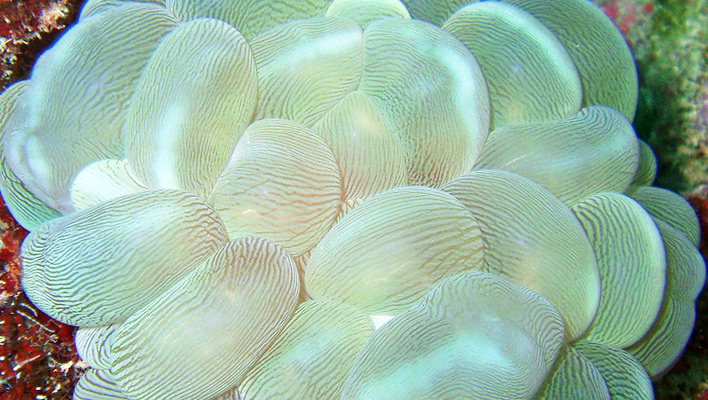Recently, I found myself musing over the livestock lineup I had in my first reef tank many years ago. Along with a variety of easy-to-keep soft corals and a handful of hardy fish, I fondly recalled that I also had a solitary large-polyp stony (LPS) coral that brought me a lot of enjoyment—a bubble coral, known taxonomically as Plerogyra sinuosa.
For as delicate as this coral looked, and its common name sounded, it proved to be quite a rugged and durable specimen. In my opinion, this wonderfully unusual-looking species is well worth keeping for beginners and experienced reefkeepers alike.
I should note that there are other so-called bubble corals in the Plerogyra and Physogyra genera, but Plerogyra sinuosa is the species you’re most likely to come across and the care requirements for each are pretty much the same.
Physical traits
P. sinuosa comes by its common name honestly, as its tentacles are modified into oval-shaped, bubble-like vesicles, which, depending on the specimen, might be white, tan, green, yellow, or even bluish in color. If you look closely at some specimens, you might also notice interesting fingerprint-like striations or shiny bands on the vesicles.
The bubbles remain expanded during the day but contract at night to reveal tapered feeding tentacles. Also after lights out, P. sinuosa is prone to producing long “sweeper” tentacles armed with stinging nematocysts, which it uses to keep neighboring corals at bay.
The bubble coral’s skeleton is irregularly cone shape and has sharp septa along the top edge, to which the vesicles are attached.
Lighting needs
 Some bubble corals are found in lower-light (even shady), turbid conditions, while others occur in brightly lit shallows, so the species is quite adaptable to different reef lighting schemes. Any time you’re transitioning a specimen from lower- to higher-intensity lighting, however, slow, careful acclimation is a must.
Some bubble corals are found in lower-light (even shady), turbid conditions, while others occur in brightly lit shallows, so the species is quite adaptable to different reef lighting schemes. Any time you’re transitioning a specimen from lower- to higher-intensity lighting, however, slow, careful acclimation is a must.
Water movement
P. sinuosa does not appreciate being subjected to powerful, linear currents. Excessive water movement can cause the coral’s tissues to be injured on the sharp skeletal septa or, at the very least, may dissuade the coral from expanding. Very gentle, turbulent water movement is best—just enough to ensure detritus doesn’t settle on the coral’s tissues.
Placement
The best reef-tank location for a bubble coral is at the bottom of the tank, with its skeleton buried partially in the substrate. It is possible to position a specimen on the rockwork higher in the tank, but this presents a few challenges. One is that the irregularly shaped skeleton can make it somewhat difficult to achieve stable placement among the rocks. Another is that these corals tend to be very top-heavy when their tissues are fully expanded, so they can easily become dislodged and topple end over end down the rocks—potentially getting injured in the process—if they aren’t securely positioned.
Also, this species’ potential to produce long sweeper tentacles should prompt you to allow a good amount of space between the bubble coral and any other invertebrate specimens.
Feeding
While bubble corals are zooxanthellate (meaning they derive nutrition from the symbiotic zooxanthellae in their tissues), they still require supplemental feedings and will exhibit much better health and growth if actively fed at least a few times a week.
Small meaty items, such as mysid shrimp or chopped seafoods, are ideal. To feed, very gently squirt the food over the coral, preferably in the evening when the feeding tentacles are extended (though it will eat during the day, as well), using a turkey baster, pipette, or eyedropper. Then, sit back and enjoy the fascinating, slow-motion spectacle of the bubble coral ingesting its food.




I love bubble corals. They are probably the easiest, longest living corals we have available to the home aquarist. As was said, they do much better if you feed them. IMO the best food for these corals and any coral that can eat are clams. I don’t like feeding anything to corals that have shells on them like shrimp as they don’t deal with shells well although they will eat them. Clams are soft and totally edible. (I eat them all the time myself) I feed clams to corals (and the entire tank) with one of these. http://i258.photobucket.com/albums/hh270/urchsearch/feeders001.jpg
But a regular turkey baster also works well.
Great article makes me want to go out and buy one
Keep up the good work guys thanks and keep them coming
Don
Thanks for your kind comment, Don!